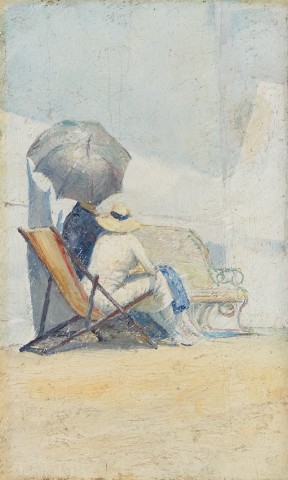SUMMER AFTERNOON, c.1919
TOM ROBERTS
oil on cedar panel
20.5 x 12.0 cm
signed lower left: Tom Roberts
Miss Emily M. Giddy, Melbourne
Thence by descent
Mrs H.W. Giddy, Melbourne
Joseph Brown Gallery, Melbourne
Jack Manton, Queensland
Thence by descent
Jennifer Manton, Sydney
Estate of the above, Sydney
possibly Catalogue of Paintings (English and Australian) by Tom Roberts, Anthony Hordern & Sons Ltd, Sydney, 16 August 1920, cat. 26
Winter Exhibitions 1976, Recent Acquisitions, Joseph Brown Gallery, Melbourne, 7 – 18 June 1976, cat. 19 (as ‘A lady and gentleman seated under an umbrella on the esplanade, c.1920’, illus. in exhibition catalogue)
Spate, V., ‘Tom Roberts’ Catalogue’, in Tom Roberts and Australian Impressionism, 1869 to 1903’, MA thesis, University of Melbourne, Melbourne, 1962, cat. 446 (as ‘Two Women Seated in Conversation’)
Topliss, H., Tom Roberts, 1856-1931: A Catalogue Raisonné, Oxford University Press, Melbourne, 1985, vol. I, p. 193, cat. 484 (as ‘Untitled. A Lady and a Gentleman Seated Under an Umbrella, c.1919’); vol. II, pl. 202 (illus.)
Summer Afternoon, c.1919, is of one of the most individual works in Tom Roberts’ oeuvre. It is also one of the most elusive. In the past, it has resisted identification. Virginia Spate, in her 1962 pioneering study of Roberts, possibly gave it the title ‘Two Women Seated in Conversation’. The model for the woman she said was Roberts’ friend Emily Giddy, sister of Sir Harold Giddy.1 In her catalogue raisonné of 1985, Helen Topliss listed it as ‘Untitled. A Lady and a Gentleman Seated Under an Umbrella’.2 Our title of ‘Summer Afternoon’ is taken from the painting of the same size Roberts exhibited in 1920 at Melbourne’s Athenaeum Hall in March and Anthony Hordern & Sons, Sydney in August.3 Further, it is known that Roberts was painting landscapes in Cornwall during the spring of 1919,4 although the painting offers no clue to its location.
The seasons had a special appeal for Roberts, particularly the sunny ones. This is apparent in the early paintings of the bushlands and beaches of Melbourne and Sydney. Significant early examples include A Summer Morning Tiff, 1886 (Art Gallery of Ballarat), painted at Houston’s farm, Box Hill, and the sparkling Holiday Sketch at Coogee, 1888 (Art Gallery of New South Wales, Sydney) painted in company with Charles Conder during an Easter visit to Coogee. Returning to England in 1903, Roberts quickly came to terms with the engaging atmospheric and cultural differences, witnessed in such works of Whistlerian subtlety as The Towpath, Putney, c.1904 (Kerry Stokes Collection, Perth) and Putney Bridge, London, c.1905 (Art Gallery of South Australia, Adelaide, M.J.M. Carter Collection). Later there are warmer days, as in Springtime in Sussex, 1921 (Art Gallery of New South Wales), described by Anne Gray, as ‘quintessentially English’.5
Our painting, Summer Afternoon, c.1919, is of quite a different kind, although its roots derive from that past. The enigmatic can be found in the Venetian Woman on a Balcony, 1884 (private collection), and the chic woman seated out-of-doors in Lady with a Parasol, c.1889 (sold by Deutscher and Hackett, Sydney, 30 August 2017, lot 11). To each, with the wonderful atmosphere that comes from having been painted en plein air, Roberts adds characteristic individual subtleties of light and colour.
Summer Afternoon has an intriguing anonymity. The two figures, seen from the side, turn their faces away from the viewer, the anonymity of the couple extended to the unidentified location. Absence of narrative heightens curiosity. At midday, when life stands still in startling clarity, Roberts evokes feelings of tantalising expectancy, the brevity of the noonday shadows countered by the imaginative shade cast by the umbrella. Bathed in the bright, white light of a summer’s day, the beach chair and its occupant are the most clearly defined features - the cast iron work nearby providing a touch of decorative invention.
By translating actuality into poetic invention, Summer Afternoon, c.1919 is filled with creativity and individuality. Overflowing with enveloping atmosphere and lively brushstrokes, the restricted palette is masterfully handled.
1. See Topliss, H., Tom Roberts, 1856-1931: A Catalogue Raisonné, Oxford University Press, Melbourne, 1985, vol. 1, p. 193, and Spate, V., ‘Tom Roberts’ Catalogue’, in Tom Roberts and Australian Impressionism, 1869 to 1903’, MA thesis, University of Melbourne, 1962, cat. 446.
2. Emily Giddy also sat for Roberts’ portrait, The Elusive Louisa, c. 1910-14, (Topliss, H., ibid., cat. 427), once in the famed Jack Manton collection of Heidelberg School artists.
3. Exhibition of Paintings by Tom Roberts, Athenaeum Hall, Melbourne, 30 March – 17 April 1920, cat. 67, and Tom Roberts, Anthony Hordern & Sons, Sydney 16 August 1920, cat. 26
4. Topliss, H., op. cit., vol. 1, p. 76
5. Gray, A., Tom Roberts, National Gallery of Australia, Canberra, 2015, p. 291
DAVID THOMAS
